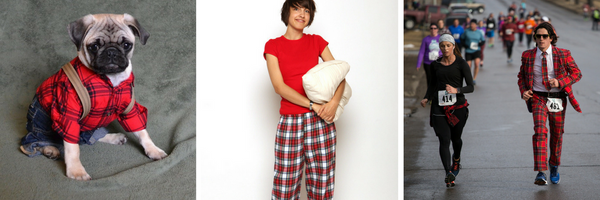Flannel vs Plaid
Let’s start with a quiz: which of these is flannel?
The answer: All of the above!
Ok, maybe that wasn’t fair. It is hard to tell from a photograph what is flannel and what isn’t. The point here is, flannel is not the same thing as plaid! Flannel refers to the fabric and weave of a shirt, where as plaid refers to the pattern. Plaid flannel shirts are, however, very popular so it is easy to be confused. Even Google seems to think they’re synonymous (image searches for flannel almost entirely show plaid flannel). Not to fear! We will explain the meaning, history and cultural significance of flannel below - there’s a lot more to it than you may think!
Meaning
Flannel is typically made from soft cotton, wool or synthetic fabrics and has a thicker weave than other types of shirts which makes it durable and great for colder weather. Flannel fabric can be brushed for an even fuzzier texture. Brushed flannel is created by running a fine metal comb over the fabric (before or after weaving). Flannel garments may be left without brushing, completely brushed, or even brushed on select sides! The shirt below has a brushed flannel exterior and classic flannel interior. Can you tell the difference?
The beautiful, fuzzy brushed flannel lends itself to a ridiculously soft to the touch finish.
The other main difference with flannel is the way the yarn is woven. Unlike other fabrics where the weave is the main differentiator, flannels can be woven in different ways - as long as the weave is loose! By loosely weaving the yarn, flannel fabrics have more air pockets in the fibers. This is part of what makes flannel more insulating than other fabrics!
History
Flannel fabric is believed to have originated in either Scotland or Wales and was traditionally made from carded wool or yarns that were finer, smoother and heavier than other yarns. To prepare the wool for weaving, it was carded - brushed and detangled. This preparation and material resulted in a heavier, more durable fabric which quickly gained popularity. With an abundance of sheep and technological advances flannel became even easier to produce, helping it gain popularity around the world. Flannel was quickly adopted for the use of plaid apparel - leading to the association between the two - but remember! Plaid is a pattern, flannel is a fabric. For more on the history of plaid, check out our earlier blog post that goes into the rich heritage of plaid patterns.
Flannel was first produced in the United States around the time of the industrial revolution. The fabric quickly became associated with the working class as it was often worn by workers building the railroad system. This image was eventually boosted through folklore images such as Paul Bunyan and his trusty Ox.
The association between flannel and the working class remained so strong that it was even used by American Senator Lamar Alexander in 1978 who won his seat in Tennessee after a publicity stunt where he wore a red and black flannel shirt as he walked across the state. This appeal to the working class worked - he remained in his seat for 8 years.
Cultural Significance
In more recent years, flannel has evolved from a symbol of the working class. Although it remains a perfect fabric for the more rugged, outdoorsy type, bands like Pearl Jam and Nirvana turned flannel into a symbol of the grunge scene of the 1990s.
Flannel today is used for many purposes and by folks of all genders, backgrounds, income and interests: outdoorsmen, hipsters, people into grunge, drag queens, fashion forward professionals, parents, children, professors, students, dogs, on and on and on! Flannel is for everyone!
So, do you have a flannel shirt of your very own? Are you ready for this softness? Check out our beautiful collection of flannel shirts (plaid or otherwise) and get your own today!




















